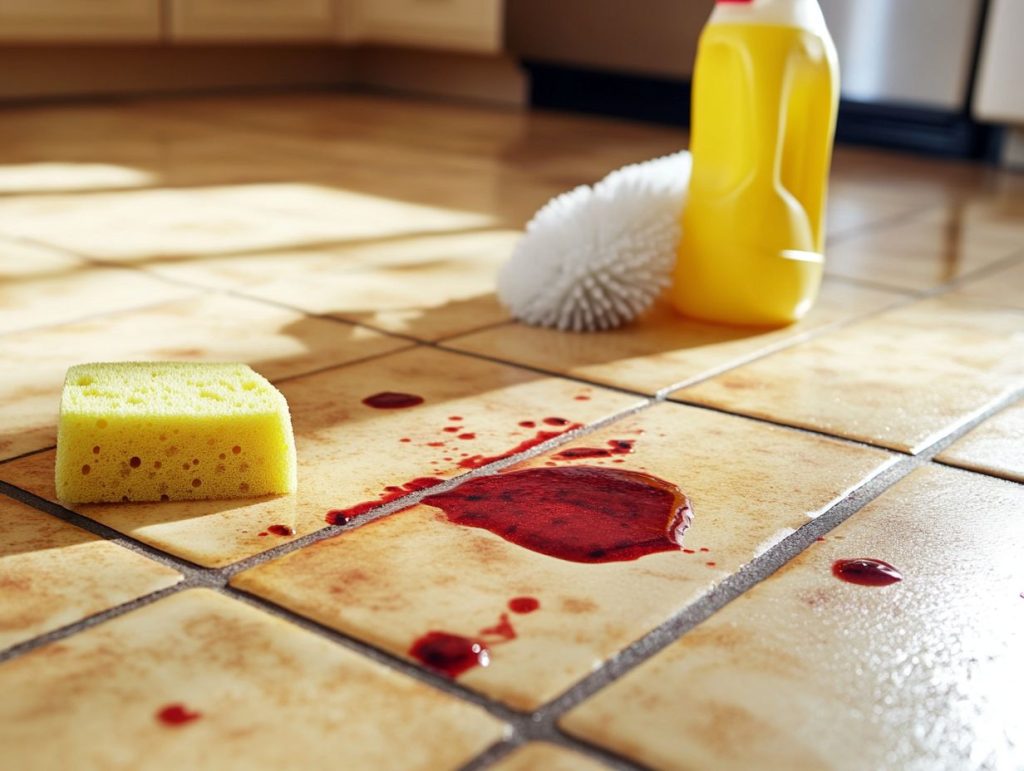How to Get Rid of Tough Food Stains on Ceramic Tiles
Ceramic tiles are a popular choice for homes due to their durability and aesthetic appeal, but they can be prone to stubborn food stains. Whether it’s a splash of sauce or a sprinkle of spices, understanding how to identify and tackle these stains is essential for maintaining your tiles’ beauty.
This guide covers the different types of stains, preventative measures, effective cleaning techniques, and the choice between homemade and store-bought cleaners. Best practices tailored to various ceramic tile types will ensure you have all the tools needed to keep your tiles looking pristine.

What Makes Ceramic Tiles So Popular
Ceramic tiles are a fantastic choice for flooring and wall coverings because they are durable, come in many styles, and are extremely easy to maintain. You will find them in all sorts of places, from homes to offices to commercial spaces.
To get the most out of ceramic tiles, it helps to know a bit about their composition, benefits, and care requirements, especially in kitchens and bathrooms. Proper maintenance can avoid problems such as colour fading and surface damage, ensuring your ceramic tiles look great for years.
What are Ceramic Tiles?
Ceramic tiles are crafted from natural clay and minerals and fired at high temperatures, creating a durable and versatile material perfect for a variety of uses.
The manufacturing process is fairly meticulous. It involves blending specific clays, shaping them into desired forms, and subjecting them to intense heat. This enhances their strength and opens up a world of finishes from which you can choose.
Homeowners and designers are drawn to these tiles for their impressive aesthetic variety. They can mimic the appearance of natural stone or wood or even feature vibrant colour patterns.
But it’s not just about appearance. The benefits of ceramic tiles go beyond the surface. They’re exceptionally durable, ideal for high-traffic areas, and resist moisture, stains, and fading. This combination of strength and style makes ceramic an excellent choice for any space you wish to enhance.
Common Types of Food Stains on Ceramic Tiles
Ceramic tiles in kitchens and bathrooms are bound to encounter all sorts of food stains, from stubborn grease to oil marks and leftover food residue that can tarnish their appearance. Understanding these common stains is extremely important for effective tile maintenance and cleaning.
Different stains require different approaches for successful removal, so identifying them helps you choose the right cleaning methods and solutions. This way, you can keep your ceramic tiles looking clean and beautiful!
Identifying Different Types of Stains
Identifying the different stains on your ceramic tiles is extremely important for selecting the right cleaning solutions. After all, stains from food dyes or pet messes require specific approaches.
Each stain has unique characteristics that can provide valuable clues for proper identification. For example, oil-based stains might appear greasy and attract dirt, while water-based stains often leave a dull or discoloured patch behind. Recognising where the stain originated helps you choose the most effective cleaning product and reduces the risk of damaging your tiles.
By understanding the distinct features of each type of stain, you can ensure you’re using the right cleaning method to keep your tiles looking pristine and to help them last longer.
Preventing Food Stains on Ceramic Tiles
Preventing food stains on ceramic tiles is much easier than removing them later, so having a few stain prevention strategies is essential for keeping them in top condition.
Cleaning regularly and using protective sealants can significantly reduce the risk of stains and keep your tiles pristine.
With just a few simple preventative measures, you can enjoy the beauty of your ceramic tiles without the hassle of time-consuming stain removal later on.
Effective Cleaning and Maintenance Tips
Effective cleaning and maintenance tips for your ceramic tiles help preserve their aesthetic appeal and longevity, ensuring your investment lasts for years.
You’ll want to explore a range of cleaning methods, from simple DIY solutions to more powerful commercial options. Common household ingredients like vinegar and bicarbonate of soda often achieve impressive results, tackling grime without harsh chemicals. If you prefer something more specialised, tile cleaners promise deeper cleaning and protection against stains.
Regular maintenance is key—wiping up spills promptly and using rugs can greatly enhance the durability and appearance of your ceramic tiles. By emphasising the importance of proper care, you’ll keep your tiles looking their best and extend their lifespan, making all that effort worthwhile.
Removing Tough Food Stains
Removing tough food stains from ceramic tiles can be a real challenge, but you can bring those tiles back to life with the right cleaning solutions and techniques.
Stubborn stains, such as grease or food residue, usually require a mix of gentle scrubbing and specific cleaning agents to lift the stain without damaging the tile surface. By knowing how to tackle stain removal, you’ll keep your ceramic tiles looking vibrant and clean.
Step-by-Step Guide to Removing Stains
A step-by-step guide to removing stains from ceramic tiles gives you the know-how to tackle tough spots easily and effectively.
Knowing the proper techniques can make a difference if you’re dealing with stubborn grease from a kitchen mishap or a splash of red wine from that dinner party. Remember, not all stains are created equal; some might need a little soap and water, while others could require a more heavy-duty cleaner.
In this guide, you’ll discover a range of effective stain removal techniques, along with specific cleaning tools like microfibre cloths and soft-bristled brushes. You’ll also find recommended products that can enhance your cleaning routine. With this approach, you can keep your ceramic tiles pristine and inviting.
Homemade vs. Store-Bought Cleaners
When cleaning your ceramic tiles, one significant decision you face is whether to use homemade cleaners or shop-bought ones. Each has its advantages.
Homemade cleaners, often made from natural ingredients like vinegar and bicarbonate of soda, are an eco-friendly option. On the other hand, shop-bought cleaners might have specialised formulas designed to tackle specific stains.
By weighing the pros and cons of each option, you can find the best cleaning solution for your ceramic tiles.
Pros and Cons of Each Option
Understanding the pros and cons of homemade versus commercial cleaning solutions helps you decide how to care for your ceramic tiles. Both options have unique advantages and drawbacks that affect how efficiently you clean and how well they work.
Homemade cleaners often use natural ingredients, making them safer for your family and the environment. However, they might not pack the same punch when disinfecting as some commercial products. On the flip side, commercial cleaners can offer a quick and convenient solution. Still, they often contain harsh chemicals that could interfere with indoor air quality and even shorten the lifespan of your tiles.
You can determine which cleaner best fits your needs and priorities by weighing these factors.
Special Considerations for Different Types of Ceramic Tiles
When cleaning and maintaining ceramic tiles, different types might need special attention. Their finishes and durability vary.
For example, glazed tiles are usually easy to clean, while unglazed tiles can be more porous and tend to absorb stains more easily. Knowing these differences is key to taking good care of your tiles, helping them last longer and keeping them looking great.
Best Practices for Cleaning and Stain Removal
Implementing the best cleaning and stain removal practices will make it easier for you to maintain your ceramic tiles efficiently and effectively.
Not only does this keep their shine intact, but it also extends their lifespan, so they look fantastic for years. While ceramic tiles are quite durable, they can still be ruined by various stains, from food spills to dirt build-up. Knowing the right cleaning techniques for different tile types is crucial if you want those surfaces to remain pristine.
For example, a gentle mix of vinegar and water works wonders for light stains. However, if you’re dealing with tougher grime, a pH-neutral cleaner is the way to go—it won’t damage the tile’s finish. With the right approach, keeping your tiles in tip-top condition becomes a breeze!
Final Tips and Tricks
As you conclude this guide, here are some tips and tricks for tackling those stubborn stains and keeping your ceramic tiles looking smart.
Adhering to a consistent cleaning schedule and clever cleaning hacks can enhance your tile care routine. This way, you can maintain the beauty of your surfaces without putting in much effort.
Additional Methods for Tough Stains
Trying a few extra methods helps restore your ceramic tiles to their former glory when dealing with tough stains.
For example, mixing bicarbonate of soda and vinegar can work wonders. It effectively breaks down grease and grime without relying on harsh chemicals. If you prefer something ready-made, a commercial tile cleaner can be a game changer; many of them are specifically designed for stubborn stains and pack a concentrated punch.
You can also whip up a paste with hydrogen peroxide and bicarbonate of soda, apply it to the stained area, and let it sit for a bit before giving it a good scrub. And don’t underestimate the power of a soft-bristled brush—it can help lift away dirt without scratching the surface.
Just remember to rinse thoroughly after cleaning to avoid any residue build-up.


